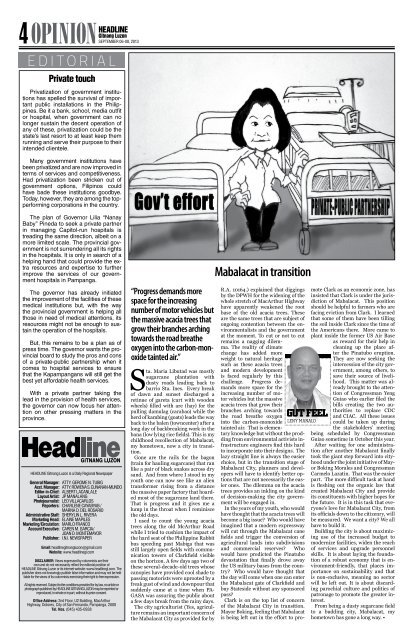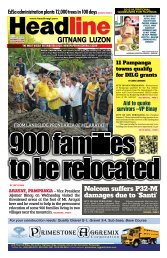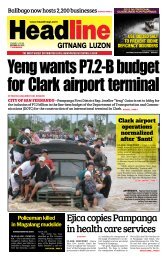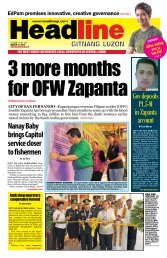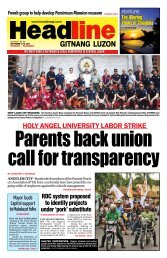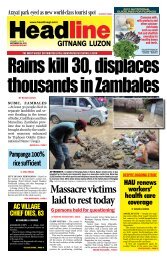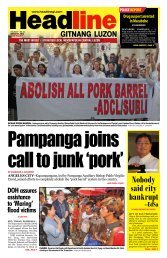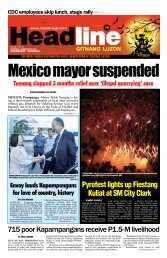4EDITORIALPrivate touch<strong>Headline</strong><strong>Gitnang</strong> <strong>Luzon</strong>SEPTEMBER 06-08, 2013Privatization <strong>of</strong> government institutionshas spelled the survival <strong>of</strong> importantpublic installations in the Philippines.Be it a bank, school, media outfitor hospital, when government can nolonger sustain the decent operation <strong>of</strong>any <strong>of</strong> these, privatization could be thestate’s last resort to at least keep themrunning and serve their purpose to theirintended clientele.Many government institutions havebeen privatized and are now improved interms <strong>of</strong> services and competitiveness.Had privatization been stricken out <strong>of</strong>government options, Filipinos couldhave bade these institutions goodbye.Today, however, they are among the topperformingcorporations in the country.The plan <strong>of</strong> Governor Lilia “NanayBaby” Pineda to seek a private partnerin managing Capitol-run hospitals istreading the same direction, albeit on amore limited scale. The provincial governmentis not surrendering all its rightsin the hospitals. It is only in search <strong>of</strong> ahelping hand that could provide the extraresources and expertise to furtherimprove the services <strong>of</strong> our governmenthospitals in Pampanga.The governor has already initiatedthe improvement <strong>of</strong> the facilities <strong>of</strong> thesemedical institutions but, with the waythe provincial government is helping allthose in need <strong>of</strong> medical attentions, itsresources might not be enough to sustainthe operation <strong>of</strong> the hospitals.But, this remains to be a plan as <strong>of</strong>press time. The governor wants the provincialboard to study the pros and cons<strong>of</strong> a private-public partnership when itcomes to hospital services to ensurethat the Kapampangans will still get thebest yet affordable health services.With a private partner taking thelead in the provision <strong>of</strong> health services,the governor can now focus her attentionon other pressing matters in theprovince.HEADLINE <strong>Gitnang</strong> <strong>Luzon</strong> is a Daily Regional NewspaperGeneral Manager: Atty. Gerome n. TubigAsst. Manager: atty. rOWENA S. CUNANAN-MUNDOEditor-in-Chief: albert lacanlaleLayout Artist: JP ManalangPhotojournalist: Leo villacarlosReporters: CHARLENE CAYABYAB /MARNA D. DEL ROSARIOAdministrative Staff: sherylin l. riveraMarketing Head: ELAINE MAPILESMarketing/Circulation: Marlo francoAccount Executive: caren m. garcia/JOAN d. montemayorPublisher: I.N.I. NewspaperEmail: headlinegitnangluzon@gmail.comWebsite: www.headlinegl.comDISCLAIMER: Views expressed by columnists are theirown and do not necessarily reflect the editorial position <strong>of</strong>HEADLINE <strong>Gitnang</strong> <strong>Luzon</strong> or its internet website: www.headlinegl.com. Thepublisher does not knowingly publish false information and may not be heldliable for the views <strong>of</strong> its columnists exercising their right to free expression.All rights reserved. Subject to the conditions provided for by law, no article orphotograph published by HEADLINE GITNANG LUZON may be reprinted orreproduced, in whole or in part, without its prior consent.Office Address: 2nd Floor, U2 Building, MacArthurHighway, Dolores, City <strong>of</strong> San Fernando, Pampanga, 2000Tel. Nos. (045) 435-0938“Progress demands morespace for the increasingnumber <strong>of</strong> motor vehicles butthe massive acacia trees thatgrow their branches archingtowards the road breatheoxygen into the carbon-monoxidetainted air.”Sta. Maria Libutad was mostlysugarcane plantation withdusty roads leading back tobarrio Sta. Ines. Every break<strong>of</strong> dawn and sunset discharged aretinue <strong>of</strong> gareta (cart with woodenwheels) filled with are (hay) for thepulling damulag (carabao) while theherd <strong>of</strong> kambing (goats) leads the wayback to the balen (towncenter) after along day <strong>of</strong> backbreaking work in thebana (low lying rice fields). This is mychildhood recollection <strong>of</strong> Mabalacat,my hometown, now a <strong>city</strong> in transition.Gone are the rails for the bagon(train for hauling sugarcane) that ranlike a pair <strong>of</strong> black snakes across dry<strong>san</strong>d. And from where I stood in myyouth one can now see like an alientransformer rising from a distancethe massive paper factory that hoardedmost <strong>of</strong> the sugarcane land there.That is progress and it gives me alump in the throat when I reminiscethe old days.I used to count the young acaciatrees along the old McArthur Roadwhile I tried to cushion the impact <strong>of</strong>the hard seat <strong>of</strong> the Philippine Rabbitbus speeding past Mabiga that wasstill largely open fields with communicationtowers <strong>of</strong> Clarkfield visibleon the horizon. A few days ago two <strong>of</strong>these several-decade-old trees whosecanopies have provided cool shade topassing motorists were uprooted by afreak gust <strong>of</strong> wind and downpour thatsuddenly came at a time when PA-GASA was assuring the public abouta few days break from the rainy days.The <strong>city</strong> agriculturist (Yes, agricultureremains an important concern <strong>of</strong>the Mabalacat City as provided for byMabalacat in transitionR.A. 10164.) explained that diggingsby the DPWH for the widening <strong>of</strong> thewhole stretch <strong>of</strong> MacArthur Highwayhave apparently weakened the rootbase <strong>of</strong> the old acacia trees. Theseare the same trees that are subject <strong>of</strong>ongoing contention between the environmentalist<strong>san</strong>d the governmentat the moment. To cut or not to cutremains a nagging dilemma.The reality <strong>of</strong> climatechange has added moreweight to natural heritagesuch as these acacia tree<strong>san</strong>d modern developmentis faced regularly by thischallenge. Progress demandsmore space for theincreasing number <strong>of</strong> motorvehicles but the massiveacacia trees that grow theirbranches arching towardsthe road breathe oxygeninto the carbon-monoxidetainted air. That is elementaryknowledge but without the proddingfrom environmental activists infrastructureengineers find this hardto incorporate into their designs. Thelazy straight line is always the easierchoice, but in the transition stage <strong>of</strong>Mabalacat City, planners and developerswill have to identify better optionsthat are not necessarily the easierones. The dilemma on the acaciatrees provides an inkling on the kind<strong>of</strong> decision-making the <strong>city</strong> governmentwill be engaged in.In the years <strong>of</strong> my youth, who wouldhave thought that the acacia trees willbecome a big issue? Who would haveimagined that a modern expresswaywill cut through the Mabalacat canefields and trigger the conversion <strong>of</strong>agricultural lands into subdivisionsgut feelLeny Manaloand commercial reserves? Whowould have predicted the Pinatubodevastation that finally drove awaythe US military bases from the country?Who would have thought thatthe day will come when one can enterthe Mabalacat gate <strong>of</strong> Clarkfield andbuy Stateside without any sponsoredpass?Clark is on the top list <strong>of</strong> concern<strong>of</strong> the Mabalacat City in transition.Mayor Boking, feeling that Mabalacatis being left out in the effort to promoteClark as an economic zone, hasinsisted that Clark is under the jurisdiction<strong>of</strong> Mabalacat. This positionshould be helpful to farmers who arefacing eviction from Clark. I learnedthat some <strong>of</strong> them have been tillingthe soil inside Clark since the time <strong>of</strong>the Americans there. More came toplant inside the former US Air Baseas reward for their help incleaning up the place afterthe Pinatubo eruption.They are now seeking theintercession <strong>of</strong> the <strong>city</strong> government,among others, tosave their source <strong>of</strong> livelihood.This matter was alreadybrought to the attention<strong>of</strong> Congressman YengGuiao who earlier filed thebills creating the two authoritiesto replace CDCand CIAC. All these issuescould be taken up duringthe stakeholders’ meetingbeing scheduled by CongressmanGuiao sometime in October this year.After waiting for one administrationafter another Mabalacat finallytook the giant step forward into <strong>city</strong>hoodunder the joint initiative <strong>of</strong> MayorBoking Morales and CongressmanCarmelo Lazatin. That was the easierpart. The more difficult task at handis fleshing out the organic law thatcreated Mabalacat City and provideits constituents with higher hopes forthe future. It is in this task that everyone’slove for Mabalacat City, fromits <strong>of</strong>ficials down to the citizenry, willbe measured. We want a <strong>city</strong>? We allhave to build it.Building the <strong>city</strong> is about maximizinguse <strong>of</strong> the increased budget tomodernize facilities, widen the reach<strong>of</strong> services and upgrade personnelskills. It is about laying the foundation<strong>of</strong> a robust economy that is environment-friendly,that places importanceon sustainability and thatis non-exclusive, meaning no sectorwill be left out. It is about discardingparochial culture and politics <strong>of</strong>patronage to promote the greater interest.From being a dusty sugarcane fieldto a budding <strong>city</strong>, Mabalacat, myhometown has gone a long way. •
<strong>Headline</strong><strong>Gitnang</strong> <strong>Luzon</strong>SEPTEMBER 06-08, 20135Passway at ilan pang katanungan sa kalsadaKung sinuman ang Hudas,Hestas, Barabas na mgakontratista nanaghukay sa kahabaanng Macarthur Highwaysa lungsod ngAngeles at iba pangpangunahing lan<strong>san</strong>gannito ay kailanganghagupitin, sabi ng mgaka-tong-its ko sa mayVilla Angela TennisClub at mga kabarkadasa Villa Gloria TennisClub.toda maxMax Sangil***Buwisit na buwisitna ang mga motorista.Kinausap ko ang City Engineer DonDizon na sabihan ang kontratista atsinabihan naman, subali’t hangangsa ngayon ay parang wala lang.Hindi pa rin inaasikaso. For thelast time, please restore what youdestroyed Mr. Contractor, whoeveryou are.***Ang aking kaibigang Jun Sula,siguro, ay buwisit na buwisit na rinsa nakikita niya araw araw sa ginagawangkalsada sa Jose Abad SantosAvenue na dating Gapan-SanFernando-Olongapo road, partikularsa may harapan ng Car World.Diyos ko! Ilang taon nang ginagawaang kalsadang ito. Saksi ako dyan atang mga kasamahan sa CLTV 36 atDWRW.Here comes another muchtalkedissue about the trees,ignited by yet another fallingtree on a vehicle with some occupantsinside it. The issue involvesenvironmental advocates and seeminglythose who are said to be cuttingthe trees in the name <strong>of</strong> infrastructuredevelopment.***A few years ago, the Department <strong>of</strong>Public Works and Highways has cuttrees along the MacArthur Highwaypurposely for the road widening projectsthe said <strong>of</strong>fice undertook. Someage-old acacia trees were cut down,sparking opposition and protestsfrom environmentalist groups whowanted to save the trees.***The issue was even elevated to thecourts as green advocates sought foran order to stop the DPWH from cuttingthe trees. The acacia trees areapparently on the road right <strong>of</strong> waythus the said <strong>of</strong>fice saw the need tocut them. The road widening projects<strong>of</strong> the DPWH involved road clearingand the cutting <strong>of</strong> the trees for thefilling, leveling and cementing <strong>of</strong> theearth for a concrete road.***Some protest actions were made bythe green advocates including someposters denouncing the cutting <strong>of</strong>trees and the painting <strong>of</strong> white humanimages on the trees’ barks thatcalls for the cutting <strong>of</strong> trees to a halt.***There were some talks made, includingthe organized Save the TreesPaging Department <strong>of</strong> PublicWorks and Highways SecretaryBabes Singson.“Pumapasok ba sa kabanng bayan ang mganasisingil dito? Malakingpera iyan! Libo-libongtruck ang dumadaandiyan araw-araw, kahitLinggo.”***‘Yun ding karsadang kaharapng SM at ng Robinsons ay matagalnang nakatiwangwang. Ano ba?Ganoon na lang ba yan? Hihintayinpa ba natin na magkaroon ng aksidentediyan bago kayo kikilos?Anong klaseng inhinyero mayroonang bansa natin? Bakit ang mgakarsada natin ay parang napakarupoksa pagka-gawa. Hindi baload vs. road strength lang yan? Obaka naman masyadong malakiang SOP?***Min<strong>san</strong>, maiisip mo tuloy na mashigit pa ang galing ng mga kapatidna Igorot na nagtayo ng rice terracessa ating mga inhinyero ngayon.Bakit kaya, sa ibang mga bansa,Why blame the trees ?Coalition. Some private groupsmeanwhile justified the cutting <strong>of</strong> thetrees in the name <strong>of</strong> development asroads will be constructed in place <strong>of</strong>the trees.***Last Sunday, Barangay PoblacionMabalacat, Pampanga chairmanMario Tiglao with hiswife and their 26-year-old“Some private groupsmeanwhile justifiedthe cutting <strong>of</strong> the treesin the name <strong>of</strong> developmentas roads willbe constructed in place<strong>of</strong> the trees.”Be heard! Send us yourcomments & opinionsdaughter, their seven-year-old granddaughterand their three-year-oldward were saved after a huge acaciatree fell on their Mitsubishi Monterowhile on their way to church.***The victims <strong>of</strong> the fallen acacia treewere left unscathed except for a littletrauma brought about by the incidentand the damage left to their vehicle. Itwas their luckiest day <strong>of</strong> the year forthe family.***Just recently, environmentalgroups blamed the Department<strong>of</strong> Public Works and Highways(DPWH) for the falling acacia tree<strong>san</strong>g mga kalsada nila ay nagtatagalhanggang limang pung taon bagonila ito kumpunihin? Bakit ditosa atin wala pang dalawang taon,lubak-lubak na?***Sino ba ang naniningil ngpassway sa mga <strong>san</strong>d andgravel truck na dumadaan sabarangay Cutcut ng Angelesat barangay Calibutbut sa Bacolor?At magkano? Pumapasokba sa kaban ng bayanang mga nasisingil dito?Malaking pera iyan! Libo-libongtruck ang dumadaan diyanaraw-araw, kahit Linggo.***Isa sa mga sikat na karsada saLungsod Angeles ay ang Fields Avenue.Dito ang sentro ng gudtaym ngmga sundalong Amerikano noongpanahong nananahan pa sila saClark Air Force Base. Sa ngayon ayito pa rin ang sentro ng aliw sa lungsod.Marami pa ring mga bar, kiosk,club at restaurant. At dumadami narin ang mga otel na naglalakihanna ang mga nagmamay-ari ay mgadayuhan.Subukan ninyong pumasyalnang gabi dito at dalhin ang buongpamilya, tiyak matutuwa kayo.May ilan pang mga kano na matatandana, pero mapapansin namula umaga, hanggang gabi aymay hawak pa ring serbesa sakamay. •along the MacArthur Highway andthat it was not the fault <strong>of</strong> the treeswhy they fall.***The Save the Trees Coalition,headed by our colleague Cecile Yumulsaid that the roots <strong>of</strong> severaltrees were cut duringthe construction<strong>of</strong> canals and roadwidening by DPWHcontractors. This hasweakened perhapsthe grip <strong>of</strong> the tree onthe ground that fell onthe vehicle <strong>of</strong> Tiglaoand his family.***The coalition wascorrect in saying thatwe should not blamethe trees for therewere some “human interventions”made why the tree fell. If not for thecutting <strong>of</strong> their roots, no mishap hashappened.iWritetomas m. garcia***The issue on the cutting <strong>of</strong> treesshould be put to rest and that awin-win solution should be madeto finally determine the fate <strong>of</strong> thetrees once and for all. It’s a battlebetween development versus theenvironment to which advocates <strong>of</strong>both sides have their own reasons.***For other opinions, comments,suggestions or adverse reactions,you may reach iWrite at 0919-5107665. ●mail US:2nd Floor, U2 Building, Dolores, McArthur,Hi-way, City <strong>of</strong> San Fernando, PampangaE-MAIL: headlinegitnangluzon@gmail.comWEBSITE: www.headlinegl.comAng espirituwalidadng pagkamuwangAminin natin na bilang mga napaka-abalang nilalangsa panahon kung kailan ang <strong>san</strong>daigdiganay abala sa mga mahahalagang pangyayaringbumabago sa ikot ng mundo at sa takbo ng kasaysayan,mahirap nang maikaila ang labis na halatang katotohananna malimit nang pansinin ng mga tao ang tunayna saysay ng mga iba’t ibang uri ng pangyayaringpumapanday sa mga samu’t saring pagbabago sa napakaramingbuhay.Ang mga naiiwan sa kamalayan ng <strong>san</strong>gkatauhanay yaon na lamang mga kaalaman na labis na halatasa i<strong>san</strong>g pangyayari. Lumabis man ang kaalaman sai<strong>san</strong>g mahalagang pangyayariay magiging tungkol pa rin angmga ito sa mga detalye ng kungano ang tunay na nangyari sai<strong>san</strong>g pangyayari. At natataposna dito ang pagkamuwangng karamihan sa i<strong>san</strong>g mahalagangpangyayari…magingang pangyayari mang ito ay sapamban<strong>san</strong>g bahagdan, pangrehiyon,o pang-lalawigan, osa pang-barangay na bahagdanlamang.At dahil na rin sa kadahilanangito ng kababawan ngating pagkamuwang sa mgamahahalaga o maging sa mgapangkaraniwang mga pangyayarilamang sa ating pangaraw-arawna buhay, hindi nanatin tunay na natatalos athindi na tayo nagkakaroon ngmalalim at matalinong kabatiranat pagkamuwang sa mgabagay na dapat <strong>san</strong>a ay maspinagtutuunan natin ng labisna matalinong pagmumuni atpag-iisip.Bakit kaya? Bakit ba ganitona lamang kababaw mag-isip atsumuri ang tao sa mga bagay nataha<strong>san</strong> namang naka-aapektosa buhay niya at sa kaniyang lipunangginagalawan?Sabi ng i<strong>san</strong>g manunulat saTowardsthe LightABEL SOTO“Sumuko si Napoleskay PNoypagkatapos ngi<strong>san</strong>g eskandalongnagkakahalaga ngsampung bilyongpiso, ano ngayonang matalinoat malalim napagkamuwangang dapat iwanansa atin ng mgapangyayaring ito?”larangan ng espirituwalidad na si Holly Whitcomb,hindi na kasi naka<strong>san</strong>ayan ng tao ang tinawag niyang“spirituality <strong>of</strong> mindfulness”, na ayon na rin sa kaniyaay matagal na ring kinalimutang bigyan ng sapatna pansin ng mga paaralan na ituro ito sa mga magaaralsa anomang asignaturang kinahaharap nila sakanilang mga silid-aralan. Sabi ni Whitcomb, “Thespirituality <strong>of</strong> mindfulness teaches us to be fully aware<strong>of</strong> each experience, letting nothing remain unnoticed,taking nothing for granted, and without delving intothe spiritual exercise <strong>of</strong> reflection.”Mahirap tutulan ang matalino at malalim na pansinna ito ni Whitcomb, sabihin pa na sa makabagong panahonnatin ngayon, ang mundo ay pinaiikot na lamangkomersiyalismo at materialismo. Sabi ko nga sa i<strong>san</strong>gliham ko sa kaibigan na nagtuturo sa Estados Unidos,it can really take a lifetime to really see flowers, feelwoods, learn the sky, walk a path, and hear what allthese things are truly saying to us about life, about ourown growth, about the spirit in the clay <strong>of</strong> us. But oncemindfulness comes and settles in, life changes entirely.Maraming namatay sa Syria at may mga namamataypa rin sa kasalukuyan, anong matalino at malalim napagkamuwang ang dapat nating maapuhap at paglimilimiinsa malagim na pangyayaring ito? Sumuko siNapoles kay PNoy pagkatapos ng i<strong>san</strong>g eskandalongnagkakahalaga ng sampung bilyong piso, ano ngayonang matalino at malalim na pagkamuwang ang dapatiwanan sa atin ng mga pangyayaring ito? Binaha angsiyudad ng San Fernando dito sa ating lalawigan ngmga ilang oras, ano ngayon ang matalino at malalimna pagkamuwang ang dapat na makita natin dito? Samga hindi matapos-tapos na kalye sa ating lalawiganna kung kailan tag-ulan at saka kinukumpuni ang mgaito (o sadyang pinaaabot ng ganitong panahon angpagkumpuni sa mga ito), ano ngayon ang matalino atmalalim na pagkamuwang ang maaari nating ibigay samga hindi na nakatutuwang mga pangyayaring ito?Nagsisimula sa mga matalino at malalim ng pagkamuwangang mga makabuluhang kasagutan sa mganapakarami at napakahahalagang mga katanungan saating mga buhay, na siya <strong>san</strong>ang aakay sa atin patungosa i<strong>san</strong>g mapagmalasakit na pagkilos para sa mga wagasna pagbabagong nais nating mangyari sa ating mgatowards the light... Page 9


